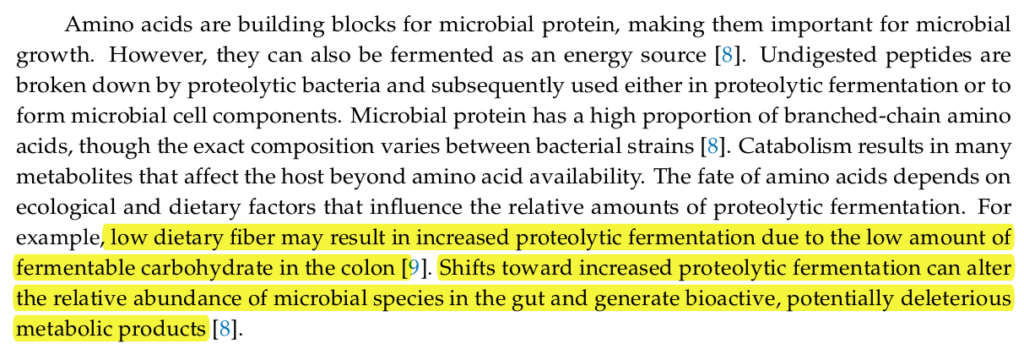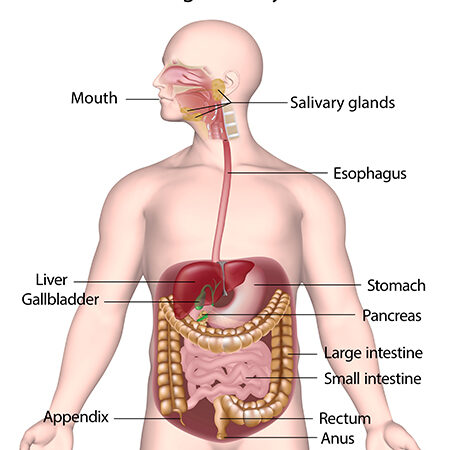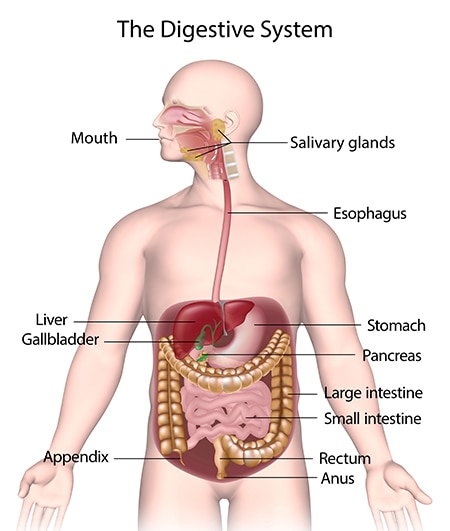SUMMARY: Bacteria eat everything we do (in varying proportions based on where in the GI tract the bacteria is located). The food you eat directly fuels different populations, and thus, everything we eat really is a “pre-biotic.”
DETAILS: In general, the term used to describe the fibers that feed our microbiome is “pre-biotics.” However, this begs the question, other than fibers, what other kinds of nutrients can our stomach bacteria eat? Can macronutrients such as proteins, fats, and carbohydrates feed our bacteria? Are proteins and fats “pre-biotics”? Are proteins and fats even able to reach our gut bacteria?
To answer this question, we need to do a little bit of digging about the digestive process, where larger macronutrients get broken down in the digestive tract, and also to figure out geolocation of our gut bacteria. Specifically, where in our intestinal tract are bacteria forming colonies, and what is the state of any nutrients that do reach these bacteria?
Question 1: Where do bacteria eat?
When we eat food, it enters the GI tract. The GI tract is a series of hollow organs joined in a long, twisting tube from the mouth to the anus. During digestion, proteins are broken down into amino acids, complex carbohydrates are broken down into simple sugars (and eventually converted to glucose), and fats are broken down into free fatty acids. Somewhere along that path, the bacteria of our microbiome feed.
As shown in Figure 1, food is chewed in the mouth and enters the esophagus. The esophagus first leads to the stomach, which leads to the small intestine, then the large intestine, and then finally to the anus. Somewhere in that path is where our microbiome exists.
There is not a lot of relevant microbial action in the esophagus (as far as we can tell). Thus, it’s safe to assume that our bacteria is not feeding purely on chewed food mixed with saliva.
Directly connecting to the esophagus is the stomach. The lower part of the stomach is where chemical digestion first begins. The stomach lining creates stomach acid and enzymes that break down our chewed food. The lower muscle mixes swallowed food with digestive juice to form “chyme”. Chyme is released into the small intestine.
Before we get to the small intestine, it’s important to note that other organs are providing fluids/juices to the small intestine. Although not directly in the flow path of food, the pancreas makes digestive juice that has enzymes that break down the macronutrients: carbohydrates, fats, and proteins. These digestive juices are delivered to the small intestine via small tubes calls ducts.
Similarly, the liver makes a digestive juice called bile that helps digests fats and some vitamins. Bile ducts carry bile from the liver to the small intestine for use (or to the gallbladder for storage — which also releases to the small intestine).
The small intestine also makes its own digestive juices to help complete the breakdown of protein, carb, and fats. Then, juices from the pancreas, liver, and small intestine are mixed together in the small intestine.
The small intestine is the first place we see evidence of microbial communities. In the small intestine, there are typically high levels of acids, oxygen and antimicrobials, and a short transit time (1). This is not a hospitable environment for bacterial growth. This environment limits bacterial growth, such that only rapidly growing, facultative anaerobes (survive in the presence of oxygen) with the ability to adhere to epithelia/mucus are thought to survive (1). For example, in mice, the small-intestine microbial community is largely dominated by Lactobacillaceae (2). Despite the fast transit times and a high degree of host absorption of peptides and amino acids as they are broken down, evidence suggests that microbial utilization of amino acids begins in the human small intestine. (https://www.mdpi.com/2076-2607/7/1/19)
Bacteria live in the small intestine and make some of the enzymes we need to digest carbohydrates. The walls of the small intestine absorb water and the digested nutrients along with it into our bloodstream. The small intestine absorbs most of the nutrients in food, and our circulatory system passes them on to other parts of our body to store or use (as broken down amino acids, fatty acids, etc.).
Waste products continue on to the large intestine (also known as the colon). These waste products include undigested parts of food, fluid, and older cells from the lining of the GI tract. The large intestine also absorbs water and changes the waste from liquid into stool. Bacteria also exist in the large intestine and help break down the remaining nutrients and also make vitamin K.
The conditions (i.e., high transit time, favorable pH, low cell turnover and redox potential) in the large intestine are thought to support a dense and diverse community of bacteria, mainly anaerobes with the ability to utilize complex carbohydrates which are undigested in the small intestine (3). In the colon, Prevotellaceae, Lachnospiraceae and Rikenellaceae have been shown to dominate. ( 3 )( 2)
Thus, it appears that the bacteria of our microbiome “live” in the small intestine and the large intestine. Most of the microbes are believed to be found in the large intestine, particularly in a pocket called the cecum (4).

Question 2: What do bacteria eat?
The quick answer: It appears that bacteria eat a little bit of everything. It is just a matter of what form the “food” has taken by the time it reaches the bacteria.
Broken down amino acids, fatty acids, and simple sugars are mostly transported across the intestinal lining into circulation. A small portion won’t be absorbed and will wind up in our poop (5). Now, in healthy folks eating a normal diet, that portion is relatively small (though it may increase a bit if you eat a lot of insoluble fiber). However, with some diseases or with extreme fat intakes, you may excrete a bit more of the food you eat. That’s generally accompanied by diarrhea or steatorrhea (Google the second term at your own risk), so it’s not something to worry about if you have normal poops.
Bacteria eat carbohydrates, particularly fiber!
Fiber will make it through your small intestine unscathed, but some of it will be broken down into fatty acids in your large intestine, and those fatty acids will also be transported to your liver. It is well known that various types of fibers are broken down into beneficial short chain fatty acids (SCFAs).
So do our microbes eat protein and fats? According to one source, no:
“According to Martens, “of all the different major nutrient groups that we eat, fiber is the one component of our diet that directly feeds our gut microbiota.” When we eat protein, for instance, we digest it and absorb it in our small intestine. The same thing happens with fats and most sugars. In the case of non-digestible fibers, we do not have the enzymes needed to break them down and digest them. Only gut bacteria can do that. They digest fibers and produce short chain fatty acids, whose beneficial effects on health are well documented, as we already explained in this blog. By eating fiber, then, we are ensuring those trillions of microbes are well-fed so they can help us stay in good health.”
However, that same source in a different article describes that gut microbiota ferment ingested proteins:
The way our gut microbiota metabolizes fats, carbohydrates and proteins affects our overall health such as our immune system and even genetic expression. A lot of research has already uncovered how certain bacteria in our intestines ferment non-digestible fibers and produce short chain fatty acids (SCFA), which have numerous health benefits. However, less is known about the effects bacteria metabolizing dietary protein have on our health. The gut microbiota ferment ingested proteins from our diet to produce small molecules called metabolites such as branched chain amino acids that can affect our metabolism. Branched chain amino acids have been linked to various metabolic conditions like type 2 diabetes and obesity, which are major public health concerns. A review published in Microorganisms summarizes recent studies that analyze the effect of the metabolites produced by the gut microbiota fermenting protein.
I have to question the veracity of these articles (which are not studies), as they describe BCAAs as being linked to type 2 diabetes and obesity. However, BCAAs are amino acids (i.e., protein constituents), well known as being linked to muscle gain. Also, the disparity in the articles causes me to question the accuracy of these articles.
Bacteria eat protein!
A 2018 review published by the Department of Agriculture from the University of Alberta, Canada, clearly describes that gut microbiota metabolize proteins:

Furthermore, there appears to be contradictory evidence regarding the harm or benefits of microbiota consuming protein. Some studies indicate increased inflammatory response, tissue permeability, and cancers. Other studies show improved gut barrier function among other things. Based on the mixed reviews, it is clear that the effect of microbes metabolizing protein NEEDS MORE RESEARCH.

Thus, it appears that undigested protein can be metabolized by gut bacteria, and this may lead to undesirable health outcomes. Furthermore, proteolytic fermentation due to low amounts of fermentable carbohydrate are able to change microbial species in the gut.

It is clear, however, that bacteria eat all kinds of amino acids, which produce metabolites having varying positive or negative downstream effects. Details of specific amino acids will be discussed in a future blog post.
Bacteria eat a little bit of fat
A very small proportion of total dietary fat reaches the colon (<5%) (6). However, microorganisms in the gut are known to possess lipases, which can degrade triglycerides and phospholipids.
How about vitamins, minerals, and other micronutrients?
Bacteria need their vitamins too (7). For example, bacteria used vitamin B6, B12, and K2 in various metabolic processes.
Along with vitamins, bacteria also utilize a variety of different phytonutrients (8). These phytonutrients are found in a variety of different plans, and their benefits will be covered in a future blog post.


